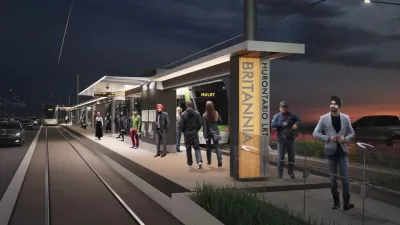Ken Greenberg, the former director of architecture and urban design for the city of Toronto, sits down to discuss how Toronto needs to transform to ensure a less auto-reliant future that serves a changing demographic of younger urban dwellers.

Toronto is at a crossroads according to the city's former director or architecture and urban design, Ken Greenberg. While the city continues to pour money into highway projects like the Gardner Expressway (saving a few commuters 2-3 minutes per day), newer residents in the city who have given up their cars (or never drove in the first place) aren't being adequately served. Luke Simcoe of Metro writes that Greenberg sees the city reacting too slowly to changes in consumer demand.
Greenberg, who helped revitalize Regent Park and is heading up the new Under Gardiner project, says the private sector has been quicker to adapt to the return of urbanism than city officials.
“Developers who are being driven by the market are providing fewer parking spaces in new buildings, for example,” he said. “We used to talk about two spaces for every unit and now we’re down in some places to one for every four units.”
Greenberg urged municipal leaders to follow suit, lest they cede their authority to developers or “disruptive” companies like Uber, Airbnb or Google.
Greenberg advises Toronto leaders to be less risk-adverse and take chances with new pilot programs with potential for positive change. "What a city really is is a giant R&D lab, full of trial and error. We need to embrace that..."
FULL STORY: 'The city is a giant R&D lab:' Architect and planner Ken Greenberg talks Toronto

Planetizen Federal Action Tracker
A weekly monitor of how Trump’s orders and actions are impacting planners and planning in America.

Maui's Vacation Rental Debate Turns Ugly
Verbal attacks, misinformation campaigns and fistfights plague a high-stakes debate to convert thousands of vacation rentals into long-term housing.

Restaurant Patios Were a Pandemic Win — Why Were They so Hard to Keep?
Social distancing requirements and changes in travel patterns prompted cities to pilot new uses for street and sidewalk space. Then it got complicated.

In California Battle of Housing vs. Environment, Housing Just Won
A new state law significantly limits the power of CEQA, an environmental review law that served as a powerful tool for blocking new development.

Boulder Eliminates Parking Minimums Citywide
Officials estimate the cost of building a single underground parking space at up to $100,000.

Orange County, Florida Adopts Largest US “Sprawl Repair” Code
The ‘Orange Code’ seeks to rectify decades of sprawl-inducing, car-oriented development.
Urban Design for Planners 1: Software Tools
This six-course series explores essential urban design concepts using open source software and equips planners with the tools they need to participate fully in the urban design process.
Planning for Universal Design
Learn the tools for implementing Universal Design in planning regulations.
Heyer Gruel & Associates PA
JM Goldson LLC
Custer County Colorado
City of Camden Redevelopment Agency
City of Astoria
Transportation Research & Education Center (TREC) at Portland State University
Jefferson Parish Government
Camden Redevelopment Agency
City of Claremont





























